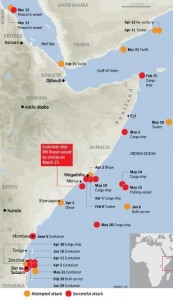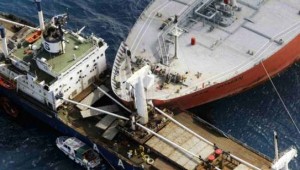
Maritime piracy is as old as the use of high seas for trade and commerce. The recent rise in attacks by Somali pirates has renewed the world’s interest in ship piracy as a crime committed on the high seas. Today the implications of a pirate attack are much more and effects far reaching than what they were couple of years back. Today the attackers are well armed and technologically sound. The English word pirate is derived from the Latin term ‘pirata’ and the Greek term ‘peirates’ meaning ‘brigand’. It means one who attacks or attempts to attack.
The UNO
Without discussing the why behind the increase in pirate attacks, this article attempts to understand the provisions of law incorporated by the United Nations Organization on maritime piracy. Piracy was dealt in detail at the United Nations Convention on the Law of the Sea in the year 1982. Article 100 of the convention placed a responsibility on all member states to cooperate for checking and repressing ship piracy at sea. Before proceeding further, it is important to look at the definition of maritime piracy as explained in the convention. Article 101 explains what is to be considered as an act of piracy.
Legal Definition of Maritime Piracy
Piracy is any illegal act of violence, detention, depredation committed by private parties, on the high seas, against another ship, persons or property on board such ship. The offence must be committed in an area which does not fall under the clear jurisdiction of any particular nation. Voluntary participation with knowledge in such acts or even inciting or facilitating such an act is to be considered as piracy.
There are two important questions that need to be answered in case of high sea offences like ship piracy.
• The first is what is the nationality of the pirate ship?
• And second, Law of which state will be applicable in case a pirate ship has been seized?
According to Article 103 of the convention, if a ship is intended to be used or has already been used for any of the purposes mentioned under Article 101, it will be considered to be a ship used for maritime piracy.
Till the time such a ship is being used to commit the crime of ship piracy and remains under the control of the guilt people, it would continue to be defined as the pirate ship under this law. The persons who control such a ship, or commit any of the acts mentioned in Article 101 are considered to be pirates.
Ship Nationality
Like human beings, ships also have a nationality. A ship gets the nationality of the state in which it has got its registration done. (Article 91) Ships have the nationality of the country of which they are entitled to fly the flag. This is true for normal ships but coming to the question of pirate ships, the law states as follows. Article 104 of the convention states a ship involved in piracy acts and falling under the definition of a pirate ship could possibly hold its original nationality, despite being classified as a pirate ship under this law. Whether such a ship will lose its nationality or continue to retain it will depend on the laws of the country in which it was originally registered.
The answer to the second question is determined by Article 105 of the Convention. Article 105 clearly gives a free reign to all countries to seize a such a ship involved in maritime piracy or under the control of the pirates. It also states that people on such a ship may be arrested and the property seized. The country which gets hold of such a ship and its pirates/property can then deal with the matter as per the law of their land and take appropriate action against the persons involved.
Article 107 of the Convention further states that it is only military ships or ships that have clearly marked that they are on government duty that can perform such seizure functions. Sometimes it may so happen that such a seizure is done in error or uncalled for. The law also makes provision that in such a case, the nation which causes such an act of irresponsible seizure shall be liable towards the country to which that ship was registered.
Of course there are several other provisions of this law but we have mainly limited ourselves to the main ones.
Although the menace of maritime piracy is age old, the picture below shows the incidents that occurred along the East African coast in the year 2007, which is still one the most piracy prone areas on the global marine map.







